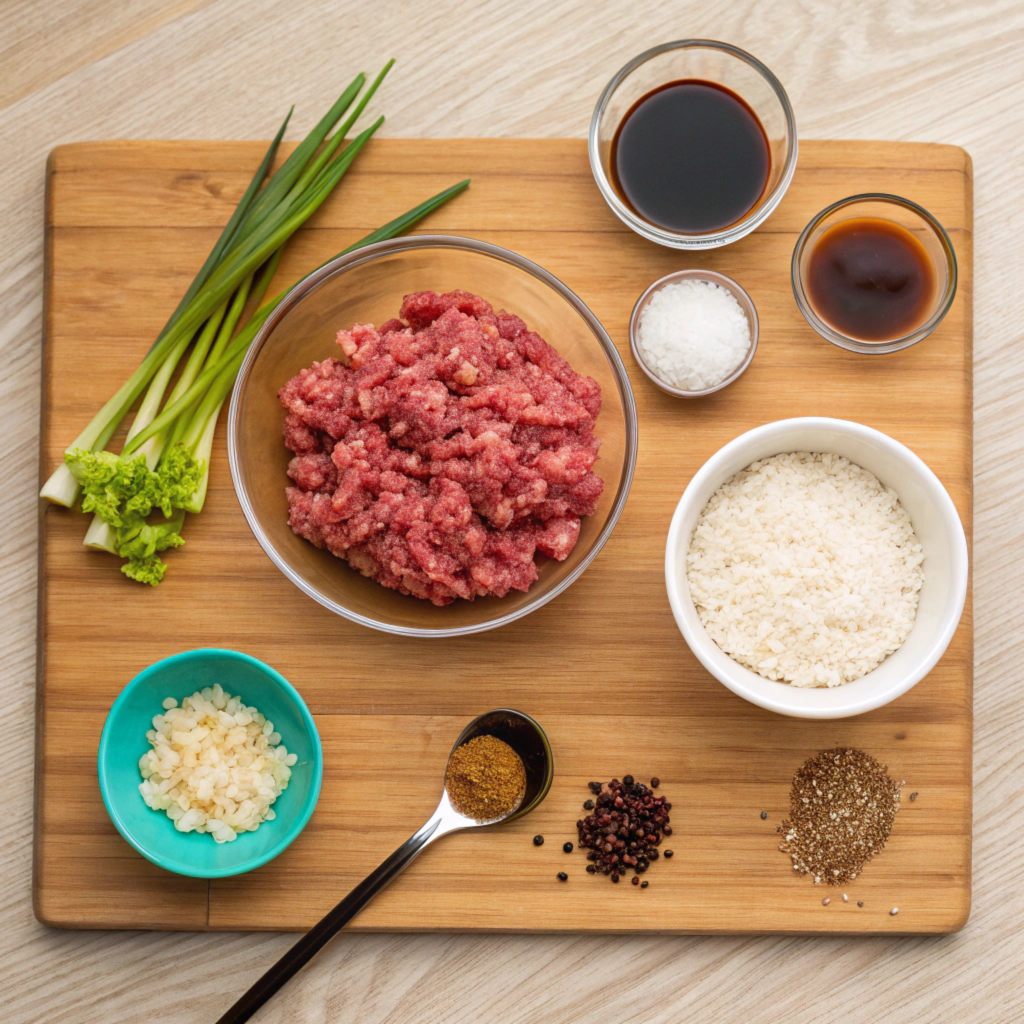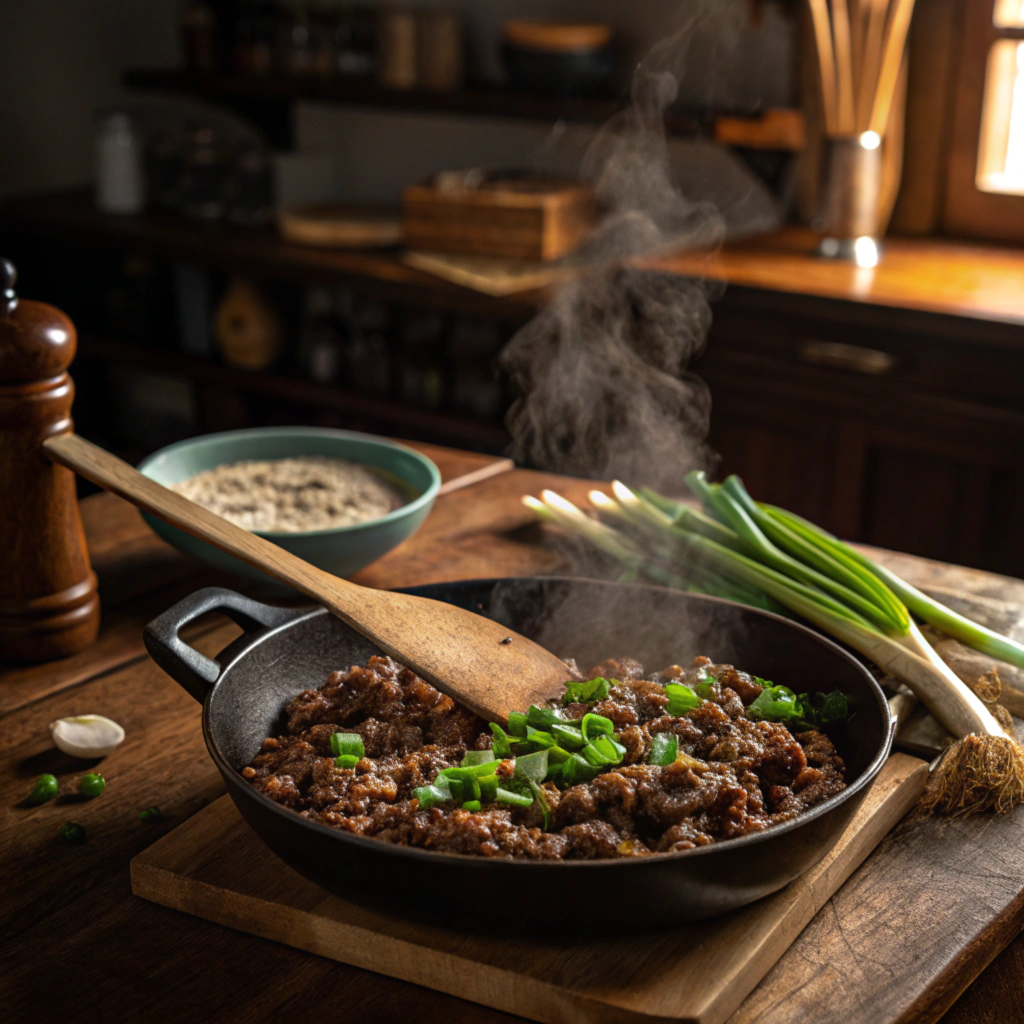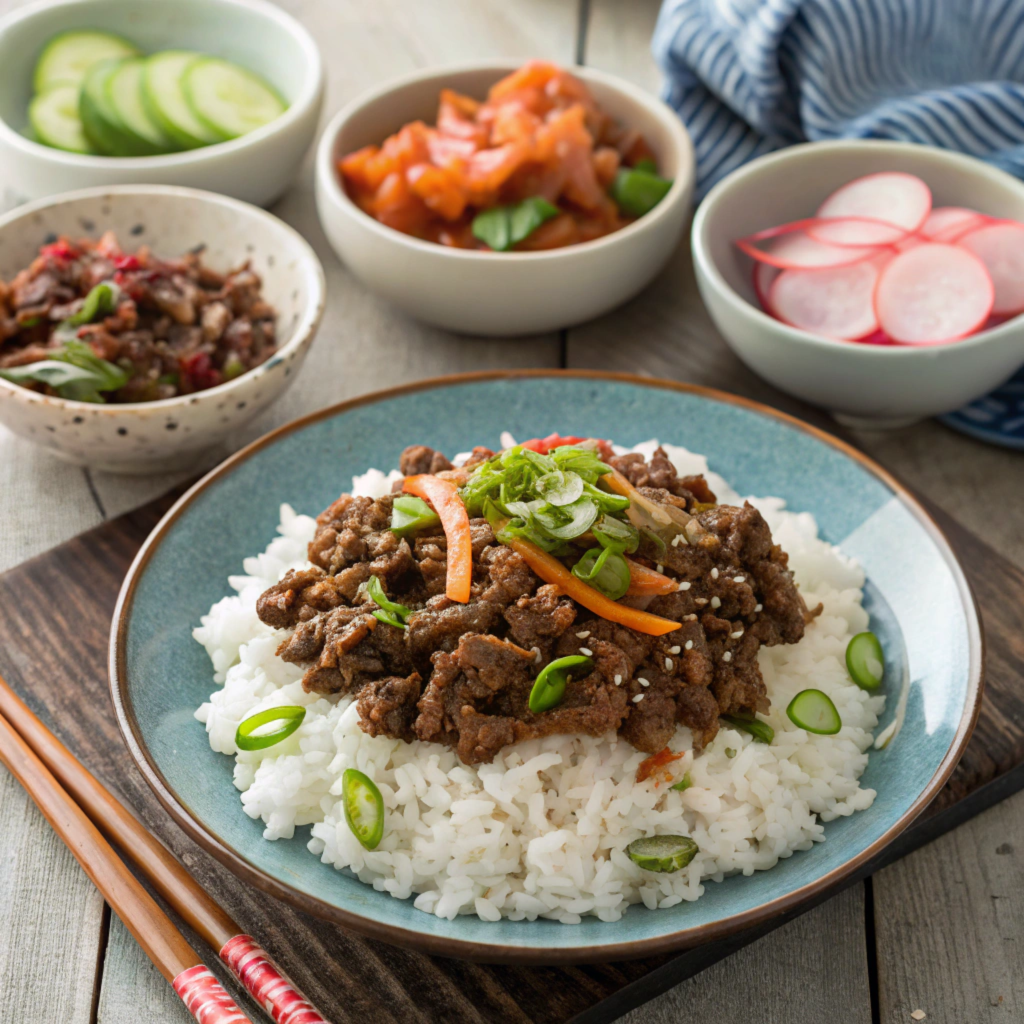If you think Korean flavors are out of reach for a quick and easy meal, think again! Ground Beef Bulgogi is here to change the game, bringing the bold, savory-sweet taste of traditional bulgogi to your table in a simple, effortless way. No fancy cuts of meat, no complex marinades, just rich umami flavors, a touch of caramelization, and a dish so versatile it can be served over rice, tucked into lettuce wraps, or even layered in a fusion-style taco.
I’ll guide you through how to make this flavorful Korean-inspired dish with pantry-friendly ingredients, plus tips to elevate its taste and customize it to your liking. Whether you’re a beginner in the kitchen or a seasoned home cook looking for a quick yet exciting dinner, this Ground Beef Bulgogi recipe will surprise you with its simplicity and deliciousness. Ready to dive in? Let’s cook up something amazing!
What Is Ground Beef Bulgogi?
The Allure of Ground Beef Bulgogi
Ground beef bulgogi is the perfect marriage of convenience and bold Korean flavors. This dish takes the essence of traditional bulgogi a sweet and savory grilled beef classic and reimagines it with ground beef for a quicker and budget-friendly alternative. With its tender texture and rich, umami-packed sauce, this recipe delivers a taste of authentic Korean cuisine in a fraction of the time.
Why This Ground Beef Bulgogi Recipe Stands Out
This ground beef bulgogi recipe stands out because of its simplicity and versatility. Requiring only a few pantry staples and fresh ingredients, it comes together in under 30 minutes, making it ideal for busy weeknights. Plus, the dish lends itself to endless customization: serve it over steamed rice, wrap it in crisp lettuce leaves, or use it as a filling for tacos. Whether you’re a seasoned fan of Korean food or a newcomer to its flavors, this dish will quickly become a household favorite.
For a deeper understanding of traditional Korean dishes and their cultural significance, explore our Comprehensive Guide to Korean Cuisine.
Essential Ingredients for Ground Beef Bulgogi

Creating ground beef bulgogi is simple, but the magic lies in balancing key ingredients. Here’s everything you’ll need to bring this dish to life:
Core Ingredients for Ground Beef Bulgogi
- Ground Beef
- Opt for lean ground beef (85–90% lean) to balance flavor and health. The fat adds richness, but excess grease can be drained after cooking.
- Onion
- A finely chopped onion contributes natural sweetness and helps build the dish’s flavor base.
- Garlic
- Freshly minced garlic is essential for the aromatic depth that makes bulgogi irresistible.
- Soy Sauce
- The cornerstone of the bulgogi sauce, soy sauce, adds umami and saltiness, creating the foundation for the dish’s savory notes.
- Brown Sugar
- This ingredient balances the saltiness of the soy sauce, lending a subtle caramelized sweetness to the dish.
- Mirin (Optional)
- A sweet rice wine, mirin enhances the sauce’s complexity and adds tanginess. You can substitute with a small amount of honey or rice vinegar if unavailable.
- Sesame Oil
- Toasted sesame oil imparts a nutty aroma that ties the dish together beautifully.
- Green Onions
- Green onions add a fresh, mild flavor and a pop of color. Use some in the cooking process and reserve the rest for garnishing.
- Sesame Seeds
- Toasted sesame seeds are sprinkled on top for extra texture and a nutty finish.
- Black Pepper
- A freshly ground black pepper pinch enhances the savory flavors and adds subtle warmth.
Optional Additions to Enhance Your Bulgogi
- Gochujang (Korean Red Pepper Paste)
- For those who enjoy a bit of spice, gochujang can be added to the sauce to create a slightly fiery, sweet-and-savory blend.
- Vegetables
- For added texture and nutritional value, feel free to incorporate shredded carrots, julienned bell peppers, or mushrooms.
Pantry Tips for Making Ground Beef Bulgogi

Most of these ingredients are staples in Korean cuisine, so investing in items like soy sauce, sesame oil, and gochujang can open the door to more Korean-inspired recipes in the future.
With these ingredients, you’re ready to dive into the heart of this flavorful dish.
How to Make Ground Beef Bulgogi
Creating ground beef bulgogi at home is quick and straightforward. Follow these step-by-step instructions to whip up this flavorful dish in no time.
Step 1: Prepare the Bulgogi Sauce
In a small bowl, mix the following ingredients:
- 4 tablespoons soy sauce
- 2 tablespoons brown sugar
- 2 tablespoons mirin (or a splash of rice vinegar for tang)
- 1 tablespoon toasted sesame oil
- 1 teaspoon freshly ground black pepper
- 1 tablespoon toasted sesame seeds
Stir until the sugar is completely dissolved and the ingredients are well combined. Then, set the sauce aside.
Step 2: Sauté the Aromatics
Heat 1 tablespoon of neutral oil (like vegetable or canola) in a large skillet over medium-high heat. Add:
- 1/2 onion, finely chopped
- 2 cloves garlic, minced
Cook for 1–2 minutes, stirring frequently, until the onion turns translucent and the garlic is fragrant.
Step 3: Cook the Ground Beef
Add 1 pound of lean ground beef to the skillet. Use a spatula to break the meat into small crumbles as it cooks. Stir often until the beef is browned and cooked through, approximately 5–7 minutes. If there is excess grease, carefully drain it from the pan.
Step 4: Add the Bulgogi Sauce
Pour the prepared bulgogi sauce over the cooked beef. Stir well to ensure the sauce coats every piece of meat evenly. Reduce the heat to medium-low and let the mixture simmer for 2–3 minutes, allowing the flavors to meld.
Step 5: Incorporate Green Onions
Stir in 2 green onions, finely sliced. Save a small handful of green onion slices for garnishing later. Cook for 1–2 minutes, then remove the skillet.
Step 6: Serve and Garnish
Transfer the ground beef bulgogi to a serving dish or plate it directly over steamed rice. Garnish with the reserved green onions and a sprinkle of toasted sesame seeds.
Serving Suggestions
- Rice Bowl: Serve over hot steamed rice for a classic presentation.
- Lettuce Wraps: Spoon the bulgogi into fresh leaves for a low-carb option.
- Fusion Tacos: Use the ground beef bulgogi as a flavorful filling for tacos, topped with shredded cabbage and a drizzle of spicy mayo.
With these simple steps, you’ll have a dish packed with bold Korean flavors in less than 30 minutes.
To perfect your steamed rice accompaniment, follow our Step-by-Step Guide to Cooking Fluffy Rice.
Tips to Customize Your Ground Beef Bulgogi
One of the best things about ground beef bulgogi is its flexibility. Whether you prefer a spicier kick, added vegetables, or creative serving options, this dish can be easily adapted to suit your taste. Here are some tips to make it your own:
Adjust the Flavor Profile
- Sweetness and Saltiness:
- For a sweeter bulgogi, stir in a tablespoon of brown sugar or honey into the sauce. To make the dish saltier, add 1–2 teaspoons more soy sauce.
- Umami Boost:
- Add a teaspoon of fish or Worcestershire sauce to deepen the umami flavors without overwhelming the dish.
- Acidity:
- For a slight tang, include a splash of rice vinegar or lime juice at the end of cooking.
Add Vegetables
Incorporating vegetables not only boosts nutrition but also adds texture and color. Try these options:
- Carrots: Shred or julienne carrots and sauté them with the onions for a touch of sweetness.
- Bell Peppers: Add thinly sliced red or green bell peppers for a subtle crunch.
- Mushrooms: Toss in sliced shiitake or button mushrooms to enhance the savory depth.
- Zucchini or Cabbage: These vegetables cook quickly and blend well with the bulgogi flavors.
Play with Spices and Heat
- Gochujang (Korean Red Pepper Paste): Mix 1 tablespoon into the sauce for a mildly spicy kick.
- Red Pepper Flakes: Sprinkle a pinch over the cooked dish for heat and color.
- Fresh Chili Peppers: Add thinly sliced red chilies for bold spice and vibrant presentation.
Experiment with Alternative Proteins
Ground beef isn’t the only option for bulgogi:
- Ground Pork: A slightly richer flavor that works beautifully with the same sauce.
- Ground Chicken or Turkey: Leaner options that still soak up the savory-sweet marinade.
- Plant-Based Proteins: Use crumbled tofu, tempeh, or plant-based ground meat for a vegetarian version.

Creative Serving Ideas
- Noodle Bowls: Toss the ground beef bulgogi with cooked udon or rice noodles for a hearty meal.
- Bulgogi Sliders: Use the bulgogi as a topping for mini buns, garnished with pickled vegetables.
- Stuffed Vegetables: Fill hollowed-out bell peppers or zucchini boats with the cooked beef mixture and bake until tender.
Garnish for Impact
A sprinkle of sesame seeds and a handful of fresh green onions are classic, but you can elevate the presentation further with:
- Sliced radishes for a crisp, fresh bite.
- Julienned cucumbers for a cooling effect.
- A fried egg on top for a more decadent, more indulgent meal.
With these customization options, you can create a unique version of ground beef bulgogi that suits your preferences and adds variety to your meal rotation.
Frequently Asked Questions
1. What is bulgogi beef made of?
Bulgogi beef is traditionally made with thinly sliced cuts like ribeye, sirloin, or brisket, chosen for their marbling and ability to absorb the marinade. This marinade typically includes soy sauce, sugar, sesame oil, garlic, and sometimes grated Asian pear or onion to tenderize and add sweetness. For ground beef bulgogi, the marinade is adapted for quicker preparation, blending directly with the beef while cooking. This results in a fast, budget-friendly dish that retains the sweet and savory flavors of traditional bulgogi. Its versatility makes it ideal for weeknight meals, meal prep, or fusion dishes like tacos and sliders.
2. What to serve with ground beef bulgogi?
Ground beef bulgogi is highly versatile, making it easy to pair with a variety of sides and accompaniments. The most common pairing is steamed white or brown rice, which absorbs the flavorful sauce and creates a balanced, hearty meal. For a low-carb option, serve the bulgogi in fresh lettuce leaves. Add rice, cucumber slices, and a sprinkle of sesame seeds for a light, satisfying wrap.
Additionally, traditional Korean banchan (side dishes) are excellent companions to elevate the meal. Kimchi adds a tangy, spicy contrast, while pickled radishes provide a crunchy, slightly sweet balance. A simple cucumber salad or steamed vegetables, such as broccoli or bok choy, can also complement the dish without overpowering it.
For those seeking a creative twist, ground beef bulgogi works well as a filling for tacos or quesadillas, topped with shredded cabbage and spicy mayo. Alternatively, it can be served over noodles, like udon or soba, for a comforting bowl meal. For a final special touch, consider topping the dish with a fried egg or a drizzle of gochujang sauce for added richness. These versatile serving options make ground beef bulgogi a meal you can quickly adapt to different tastes and occasions.
3. Why is bulgogi so chewy?
Bulgogi can become chewy if it is overcooked or if the meat isn’t adequately prepared. Traditional bulgogi uses tender cuts of beef, such as ribeye or sirloin, which are naturally soft and suited for quick cooking methods. However, if tougher cuts like chuck or flank steak are used without sufficient marinating, the result can be a chewier texture.
The marinade is essential for tenderizing the meat in traditional bulgogi. Ingredients like soy sauce, sugar, sesame oil, and grated Asian pear or onion help break down muscle fibers, resulting in a tender and juicy texture. Skipping or shortening the marination process can lead to a stricter outcome.
When cooking, high heat is typically used to achieve a quick sear and slight caramelization. Overcooking, however, can dry out the meat and cause it to become chewy. In the case of ground beef bulgogi, the risk of chewiness is lower because ground beef cooks quickly and evenly. To avoid dryness, it’s essential not to overcook the beef. By carefully selecting the cut, properly marinating, and cooking it just right, bulgogi retains its signature tender and flavorful qualities.
4. What is unique about bulgogi?
Bulgogi is notable for its rich flavor profile and cultural significance in Korean cuisine. The dish combines the perfect balance of sweet, savory, and nutty notes, making it universally appealing. The marinade is the heart of bulgogi, featuring soy sauce, sugar, sesame oil, garlic, and sometimes Asian pear or onion. These ingredients work together to create a complex taste that is bold yet harmonious.
The cooking method also contributes to its uniqueness. Bulgogi is traditionally grilled or stir-fried, allowing the marinade to caramelize and coat the meat in a glossy, flavorful glaze. This creates a slightly smoky, charred aroma when grilled or a luscious, tender texture when stir-fried.
Culturally, bulgogi represents the essence of Korean food accessible, versatile, and intensely flavorful. It is a popular choice for family meals, special occasions, and gatherings, showcasing the communal nature of Korean dining. The dish is also adaptable, inspiring variations like ground beef bulgogi and bulgogi tacos that cater to modern tastes. Its ability to combine authentic flavors with simplicity makes it a beloved dish both in Korea and around the world.
Conclusion
Ground beef bulgogi offers a flavorful and convenient way to enjoy the beloved taste of Korean cuisine. With its perfect balance of savory, sweet, and nutty notes, this dish is sure to become a staple in your dinner rotation. Whether served over rice, in wraps or as a fusion-inspired taco filling, it adapts to various preferences and occasions.
Easy to customize and quick to prepare, this recipe is an excellent introduction to Korean flavors for beginners and a satisfying meal for seasoned fans of the cuisine. Share your creations with friends and family, and don’t be afraid to experiment with your favorite add-ins and serving styles!

Ground Beef Bulgogi
Ingredients
Equipment
Method
- In a small bowl, combine soy sauce, brown sugar, mirin, sesame oil, black pepper, and sesame seeds. Stir until sugar dissolves and set aside.
- Heat neutral oil in a large skillet over medium-high heat. Add chopped onion and minced garlic. Sauté for 1–2 minutes until the onion turns translucent and garlic is fragrant.
- Add ground beef to the skillet. Break it apart with a spatula and cook for 5–7 minutes until browned and cooked through. Drain excess grease if necessary.
- Pour the prepared bulgogi sauce over the beef. Stir well to coat the meat evenly. Simmer on medium-low for 2–3 minutes to meld flavors.
- Stir in the sliced green onions, reserving a few for garnish. Cook for another 1–2 minutes.
- Serve over steamed rice, in lettuce wraps, or as taco filling. Garnish with reserved green onions and additional sesame seeds.


1 thought on “Ground Beef Bulgogi Recipe: Quick, Flavorful, and Versatile”